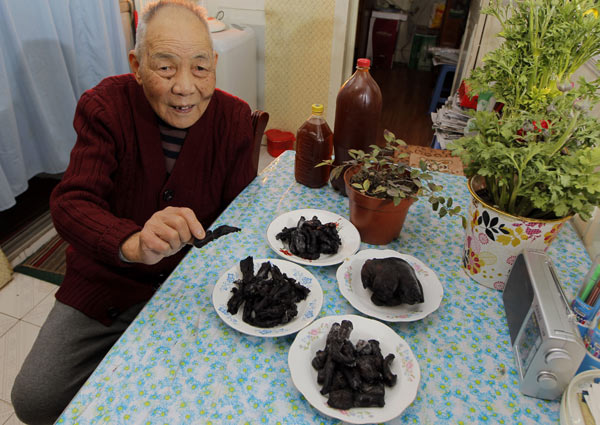He wants to taint it black
Updated: 2012-05-24 07:09
By Wang Hongyi in Nanjing (China Daily)
|
||||||||
Huang Wanjin's dining room overflows with bowls and pots, all containing pitch-black food.
The traditional dishes, such as black pig's feet, black duck's feet and black quail's eggs, were made using leaves of an evergreen shrub and have a long history in Nanjing, capital of Jiangsu province.
 |
|
Huang Wanjin, 95, shows traditional black food that he cooked up at home in Nanjing, Jiangsu province, on March 26. Gao Erqiang / for China Daily |
"It doesn't look good, but has a high nutritional value," said Huang, who at 95 years old attributes much of his longevity to eating black food.
Since retiring as an official from the local government three decades ago, Huang has tried to revive the tradition of eating black food, recovering lost recipes through trial and error.
People in Nanjing have long eaten black rice - colored by juices derived from leaves of the sea bilberry - on the eighth day of the fourth lunar month.
However, few people nowadays know or remember the other varieties of black food, which used to be popular among the city's elite in the 1930s, including officials from the Kuomintang government, Huang said.
As early as in 1928, Huang, then 11, worked as a waiter in a restaurant named Shuangfengyuan, which was opened by his cousin.
"The restaurant was small and specialized in the making of black food. It was very popular among many officials who usually sent their servants for the restaurant's takeout," Huang recalled.
Former Kuomintang leader Chiang Kai-shek and his wife Soong May-ling, were among the restaurant's regular patrons, Huang said.
"Chiang Kai-shek's favorite food was pig tendons," he said, gesturing to a bowl of translucent black pig tendons he had taken from the refrigerator.
Soong May-ling's favorite black food was pig's feet, which contain abundant collagen, Huang said.
Then, in 1937, the War of Resistance Against Japanese Aggression broke out and the restaurant disappeared, along with its recipe for black food.
"Compared with black rice, which is easy to cook, other black food such as black chicken claws have higher requirements in controlling the concentration of juices," said Huang.
"It was a long time ago. I need to recall the cooking method bit by bit."
Nutritionist Han Ting, from Shanghai No 10 People's Hospital, said the leaves used for the recipe contain vitamins and trace elements, which have some anti-aging and anti-oxidant effects.
However, the culinary revival hasn't received as warm a welcome as Huang expected.
"We residents in Nanjing have long heard about black food, but personally I don't think there is a ready market for it," said Nanjing taxi driver Liu Xiangdong.
"Though many nutritionists said black food has high nutritional value and is beneficial to people's health, such black things make people lose their appetite."
Due to its limited public acceptance, Huang hasn't found anyone interested in his recipes.
"I have only one son who worked in the field of water conservancy. He has little interest in cooking. Besides, it's not easy work, but requires time and patience. Not many people want to learn it," Huang said with a sigh.
He plans to hand the recipes to the government.
"I hope our government can do more research into the making of black food and promote it to a wider market," Huang said.
Contact the writer at wanghongyi@chinadaily.com.cn

 Relief reaches isolated village
Relief reaches isolated village
 Rainfall poses new threats to quake-hit region
Rainfall poses new threats to quake-hit region
 Funerals begin for Boston bombing victims
Funerals begin for Boston bombing victims
 Quake takeaway from China's Air Force
Quake takeaway from China's Air Force
 Obama celebrates young inventors at science fair
Obama celebrates young inventors at science fair
 Earth Day marked around the world
Earth Day marked around the world
 Volunteer team helping students find sense of normalcy
Volunteer team helping students find sense of normalcy
 Ethnic groups quick to join rescue efforts
Ethnic groups quick to join rescue efforts
Most Viewed
Editor's Picks

|

|

|

|

|

|
Today's Top News
Health new priority for quake zone
Xi meets US top military officer
Japan's boats driven out of Diaoyu
China mulls online shopping legislation
Bird flu death toll rises to 22
Putin appoints new ambassador to China
Japanese ships blocked from Diaoyu Islands
Inspired by Guan, more Chinese pick up golf
US Weekly

|

|






